Key takeaways:
- Fat content significantly affects the flavor, texture, and overall enjoyment of sausages, with pork typically having 20-30% fat for richness.
- Various factors such as animal breed, cut of meat, processing methods, and cooking techniques can alter the fat content in sausages.
- Choosing leaner meat options, incorporating vegetables, and using proper cooking techniques can effectively reduce sausage fat while maintaining flavor.

Understanding sausage fat content
When we talk about sausage fat content, it’s fascinating how much it influences both flavor and texture. Growing up, I remember biting into a perfectly grilled sausage, the burst of juiciness and rich taste was unforgettable. What I realized later is that the specific fat content not only determines that mouthwatering experience but also plays a role in how the sausage cooks and holds together.
Different types of meat deliver varying fat percentages, which is essential to consider. For instance, pork sausages typically contain around 20-30% fat, providing that delightful richness I crave. Have you ever noticed how a sausage with lower fat content can be dry and less enjoyable? It’s like a concert where the bass drops out—just not the same!
Moreover, fat in sausage isn’t merely about indulgence; it’s about balance. I often find that a certain amount of fat helps transport flavors, enhancing every bite. It’s worth pondering: do we sometimes overlook fat’s role in making our food delicious? Understanding this can change how we appreciate not just sausages but many other foods we love.
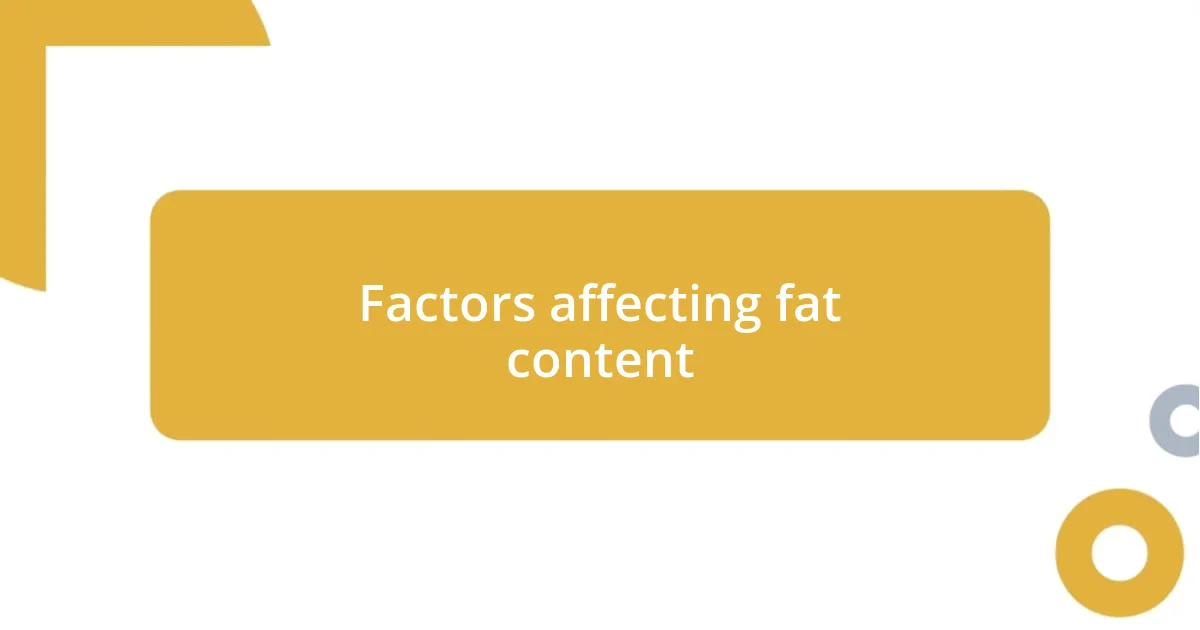
Factors affecting fat content
When it comes to fat content in sausage, several factors come into play that can dramatically alter its profile. Personally, I’ve always found it fascinating how the breed of the animal can impact the fat ratios. For example, heritage breeds tend to produce meat with a richer fat content. This is something I often look for when selecting sausages at the farmer’s market.
Here are some key factors that can affect fat content in sausages:
- Animal Breed: Different breeds have varying natural fat distributions.
- Cut of Meat: Trimmings from fattier cuts will yield higher fat content compared to leaner cuts.
- Processing Methods: How the meat is ground and mixed can influence the emulsion and distribution of fat.
- Additives: Ingredients like bacon or fatty cuts mixed in can elevate the overall fat percentage.
- Cooking Methods: The way sausages are cooked can lead to fat rendering, altering the final fat content.
Regarding personal experience, I’ve noticed that the cooking method, especially grilling, can dramatically change the perceived juiciness. I prefer to grill sausages to a crisp, allowing the fat to caramelize and enhance the flavor profile. That sizzling sound always brings back memories of summer cookouts with friends, where we’d eagerly await that first bite.
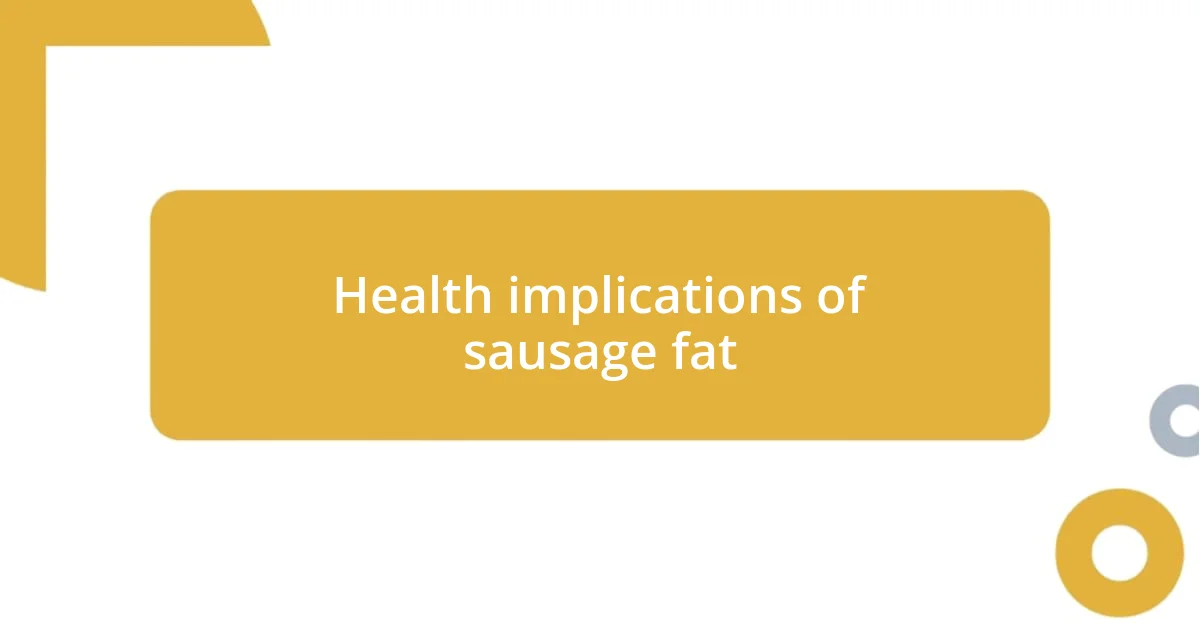
Health implications of sausage fat
The health implications of sausage fat are quite intriguing and can be complex. Interestingly, while fat does contribute to heartiness and flavor in sausages, it’s essential to consider the types of fat present. For instance, the saturated fats found in many sausages are linked to higher cholesterol levels and potential heart issues. I often reflect on the balance I seek in my diet, striving for moderation while indulging from time to time. Choosing sausages with a blend of fats can sometimes offer a more balanced approach.
In my experience, I find that not all fats are created equal. For example, sausages made from leaner cuts or those including healthier fats, like those from poultry or certain plant-based options, can offer a lighter alternative without sacrificing taste. The first time I tried a chicken sausage, I was pleasantly surprised—it was juicy and flavorful, allowing me to enjoy the familiar taste with less guilt. Have you ever experimented with different types of sausage just for the sake of health? You might discover new favorites!
Ultimately, the type and quantity of fat in sausage matter significantly. While I enjoy a good pork sausage, I also watch my overall intake. It’s helpful to be aware of serving sizes and how often I indulge. I remind myself that health is about the long game, and making informed choices on the sausages I choose can lead to a healthier relationship with food overall.
| Fat Type | Health Impact |
|---|---|
| Saturated Fat | Can raise LDL cholesterol, associated with heart disease. |
| Monounsaturated Fat | May improve heart health and reduce bad cholesterol. |
| Polyunsaturated Fat | Includes omega-3 and omega-6 fatty acids beneficial for heart health. |
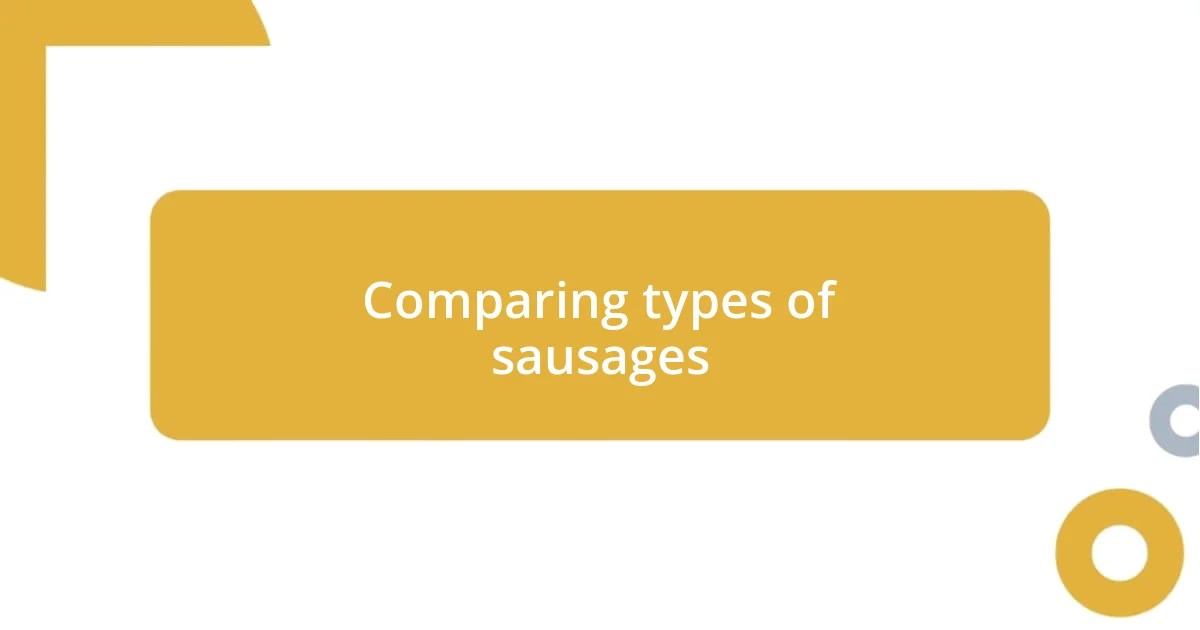
Comparing types of sausages
When comparing types of sausages, it’s fascinating to see how much variation exists. For instance, Italian sausages typically have a mix of spices and a higher fat content, which gives them that bold, savory flavor I love. On the other hand, chicken sausages are often leaner and can be just as delicious—especially when they’re infused with herbs or spices. It’s all about finding that perfect balance.
I remember my first experience with bratwurst during Oktoberfest. The juiciness and flavor profile were remarkable, a testament to the higher fat content in pork versus other options. It struck me how that richness made each bite feel indulgent yet comforting. Have you ever had a favorite sausage that you felt was a little too greasy? This can happen with certain varieties, particularly if they’re packed with additives or made from fattier cuts.
Then there are the modern alternatives like plant-based sausages, which have become quite popular. While they aim for a lower fat content, some manage to replicate that satisfying mouthfeel. I’ve tried a few, and honestly, they surprised me. Could it be that beyond just tasting good, they’re paving the way for new possibilities in the sausage world? Adapting our preferences might just open up a whole new range of flavors and experiences waiting to be discovered.
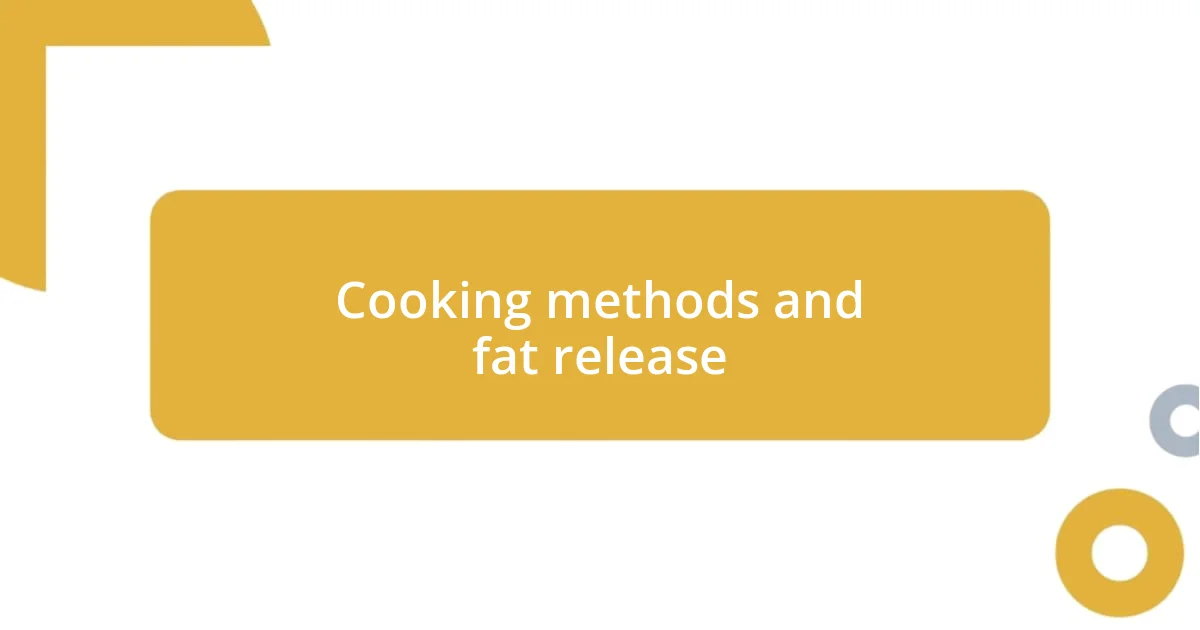
Cooking methods and fat release
Cooking sausages can vary significantly based on the method used, and I’ve learned that some techniques allow for better fat release than others. For example, grilling sausages tends to let the grease drip away, helping reduce overall fat content, which I appreciate when I’m looking to enjoy that smoky flavor without the extra guilt. Have you ever noticed how perfectly grilled sausages have a satisfying char and a wonderful aroma that just pulls you in?
When I switch things up and choose to pan-fry, I can’t deny that the rendered fat creates a luscious base that enhances the overall taste. However, I’ve found that it’s easy to oversaturate the sausage if I’m not careful. The first time I made breakfast sausages in a skillet, I was a little shocked at how much grease pooled in the pan—though the flavors melded beautifully! It made me realize that preemptively draining some of that fat can help keep sausages flavorful yet not overly greasy.
Baking is another method I often use, which allows the sausages to cook evenly without much added fat. I love the simplicity of placing a tray in the oven and letting the heat do the work. There’s something satisfying about checking back after a short while to find perfectly cooked sausages, with just the right amount of fat caramelizing on the outside. It really hits home how versatile cooking methods can be and how each has its own charm and outcome. What cooking method do you feel brings out the best in your sausages?
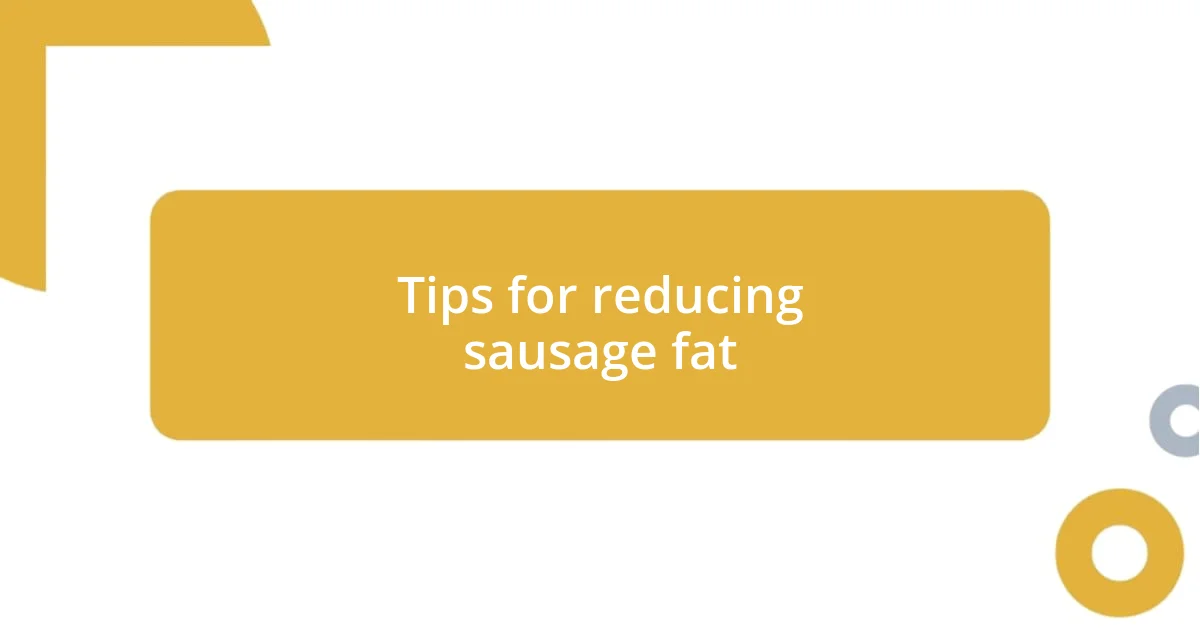
Tips for reducing sausage fat
When looking to reduce sausage fat, one effective strategy I’ve found is to choose leaner meat options. For instance, opting for turkey or chicken sausage instead of traditional pork can significantly cut down on fat without sacrificing flavor. I vividly remember my first turkey sausage breakfast—a delightful surprise, really! The herbs added a zest that made me forget the reduction in fat content. Have you ever explored swapping out your go-to sausage for a leaner option? It might just change the way you think about breakfast.
Another tip is to incorporate vegetables into the sausage mixture. Adding finely chopped onions or bell peppers not only enhances flavor but also stretches the meal further. I’ve mixed spinach into my sausage recipes before, which not only lightens the fat content but also adds a nutritious twist. Imagine biting into a sausage bursting with vibrant greens and spices! It’s delightful how such simple additions can elevate a dish while making it healthier.
Finally, I’ve realized that using proper cooking techniques can make a world of difference. If you embrace steaming or poaching before grilling, you can diminish the fat from the sausage significantly. I remember experimenting with this method during a summer cookout, and the result was a juicy sausage with half the grease I expected! Isn’t it fascinating how a little technique can reshape our culinary experiences? The right preparation and a few smart choices can lead to delicious meals that are both satisfying and kinder to our waistlines.
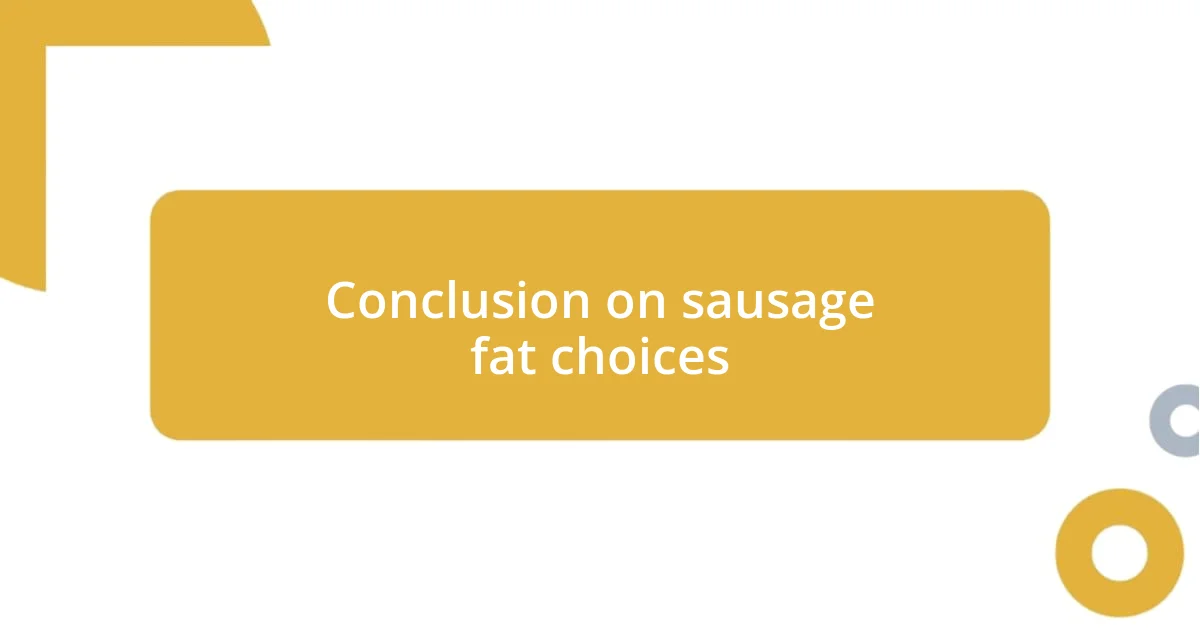
Conclusion on sausage fat choices
When considering sausage fat choices, it’s clear that understanding the balance between flavor and health is vital. I remember my first attempt at making homemade sausage, and I was shocked at how much fat rendered out during cooking. After that, I started focusing on the source of my meat, realizing that sourcing leaner cuts made a noticeable difference. Are we really willing to sacrifice flavor for fat content, or is there a happy medium?
It fascinates me how much variety exists in the type of sausages available today! The options range from rich, hearty pork varieties to lighter, herb-infused chicken sausages. I once tried a fennel-infused chicken sausage, and it packed more flavor than I anticipated. The lesson here is that exploring different types can lead to delightful surprises while being mindful of our fat intake. Have you ventured beyond your usual picks?
Ultimately, the fat content in sausage is just one piece of a larger culinary puzzle. I find that pairing sausages with fresh sides can create a well-rounded meal without overdoing it on the grease. For instance, serving my homemade sausage with a vibrant salad not only enhances the dish but reminds me of balance in healthy eating. Isn’t it exciting to think we can enjoy the richness of sausage while making choices that align with our health goals?















